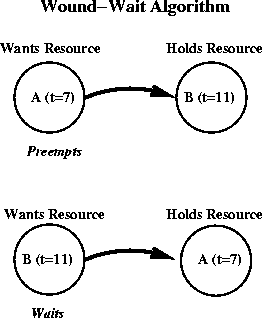prevent the No Preemption condition.
No two processes should have same timestamp.
(Tanen95)
providing the creation time of each process.
already owned by another process.
- Determine relative ages of both processes.
- Decide if waiting process should
- Preempt,
- Wait,
- Die, or
- Wound
use these ideas, as explained below:
- The Wait-Die algorithm:
Allow wait only if waiting process is older.
Since timestamps increase in any chain of waiting processes,
cycles are impossible.
The Wait-Die algorithm kills the younger process.
When the younger process restarts
and requests the resource again,
it may be killed once more.
This is the less efficient of these two algorithms. - The Wound-Wait algorithm:
Otherwise allow wait only if waiting process is younger.
Here timestamps decrease in any chain of waiting process,
so cycles are again impossible.
It is wiser to give older processes priority.
The Wound-Wait algorithm preempts the younger process.
When the younger process re-requests resource,
it has to wait for older process to finish.
This is the better of the two algorithms.
Note: To avoid starvation,
a process should not be assigned
a new timestamp each time it restarts.
